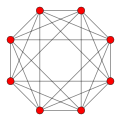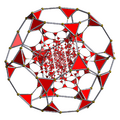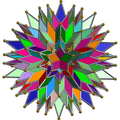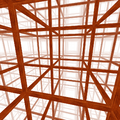4-polytope facts for kids
In geometry, a 4-polytope is a special shape that exists in four dimensions. Think of it as the 4D version of a polygon (like a square in 2D) or a polyhedron (like a cube in 3D). These amazing shapes are also sometimes called polychorons or polycells.
A 4-polytope is a closed figure, meaning it has a clear inside and outside. It's made up of different parts:
- Vertices: These are the corner points.
- Edges: These are the lines connecting the vertices.
- Faces: These are flat shapes like polygons (squares, triangles, etc.).
- Cells: These are 3D shapes like polyhedra (cubes, pyramids, etc.).
Every face in a 4-polytope is shared by exactly two cells. This is similar to how each edge of a 3D polyhedron connects exactly two faces. The first person to discover these fascinating 4D shapes was a Swiss mathematician named Ludwig Schläfli, before 1853.
Contents
What is a 4-Polytope?
A 4-polytope is a complete shape in four dimensions. It's built from smaller parts. Imagine a 3D cube is made of 2D squares (faces). A 4D shape is made of 3D shapes (cells).
Parts of a 4-Polytope
- Vertices are the points where edges meet.
- Edges are the lines connecting vertices.
- Faces are the flat polygon shapes.
- Cells are the 3D polyhedra that make up the "skin" of the 4-polytope.
Each face of a 4-polytope connects exactly two cells. This is like how each edge of a cube connects two of its square faces. Also, a 4-polytope cannot be split into two or more smaller 4-polytopes.
Exploring 4-Polytope Geometry
The most famous 4-polytope is the tesseract, also known as the hypercube. It's the 4D version of a simple 3D cube. Just like there are special 3D shapes called Platonic solids (like the cube or pyramid), there are also special 4D shapes called convex regular 4-polytopes.
The Six Regular 4-Polytopes
There are six main types of these regular 4-polytopes. They are like the "perfect" shapes in four dimensions.
- The 5-cell (like a 4D pyramid)
- The 8-cell (the tesseract or hypercube)
- The 16-cell (like a 4D diamond)
- The 24-cell
- The 120-cell
- The 600-cell
These shapes can be ordered by their "size" or "hypervolume" if they all have the same radius. The 5-cell is the smallest, and the 120-cell is the largest. As you go from the 5-cell to the 120-cell, the shapes become "rounder" and more complex.
| Regular convex 4-polytopes | |||||||
|---|---|---|---|---|---|---|---|
| Symmetry group | A4 | B4 | F4 | H4 | |||
| Name | 5-cell Hyper-tetrahedron |
16-cell Hyper-octahedron |
8-cell Hyper-cube |
24-cell
|
600-cell Hyper-icosahedron |
120-cell Hyper-dodecahedron |
|
| Schläfli symbol | {3, 3, 3} | {3, 3, 4} | {4, 3, 3} | {3, 4, 3} | {3, 3, 5} | {5, 3, 3} | |
| Coxeter mirrors | |||||||
| Mirror dihedrals | 𝝅3 𝝅3 𝝅3 𝝅2 𝝅2 𝝅2 | 𝝅3 𝝅3 𝝅4 𝝅2 𝝅2 𝝅2 | 𝝅4 𝝅3 𝝅3 𝝅2 𝝅2 𝝅2 | 𝝅3 𝝅4 𝝅3 𝝅2 𝝅2 𝝅2 | 𝝅3 𝝅3 𝝅5 𝝅2 𝝅2 𝝅2 | 𝝅5 𝝅3 𝝅3 𝝅2 𝝅2 𝝅2 | |
| Graph | 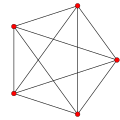 |
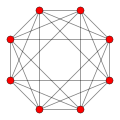 |
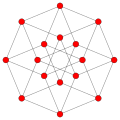 |
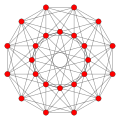 |
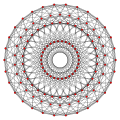 |
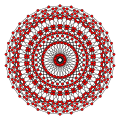 |
|
| Vertices | 5 tetrahedral | 8 octahedral | 16 tetrahedral | 24 cubical | 120 icosahedral | 600 tetrahedral | |
| Edges | 10 triangular | 24 square | 32 triangular | 96 triangular | 720 pentagonal | 1200 triangular | |
| Faces | 10 triangles | 32 triangles | 24 squares | 96 triangles | 1200 triangles | 720 pentagons | |
| Cells | 5 tetrahedra | 16 tetrahedra | 8 cubes | 24 octahedra | 600 tetrahedra | 120 dodecahedra | |
| Tori | 1 5-tetrahedron | 2 8-tetrahedron | 2 4-cube | 4 6-octahedron | 20 30-tetrahedron | 12 10-dodecahedron | |
| Inscribed | 120 in 120-cell | 675 in 120-cell | 2 16-cells | 3 8-cells | 25 24-cells | 10 600-cells | |
| Great polygons | 2 squares x 3 | 4 rectangles x 4 | 4 hexagons x 4 | 12 decagons x 6 | 100 irregular hexagons x 4 | ||
| Petrie polygons | 1 pentagon | 1 octagon | 2 octagons | 2 dodecagons | 4 30-gons | 20 30-gons | |
| Long radius |  |
 |
 |
 |
 |
 |
|
| Edge length |  |
 |
 |
 |
 |
 |
|
| Short radius |  |
 |
 |
 |
 |
 |
|
| Area |  |
 |
 |
 |
 |
 |
|
| Volume |  |
 |
 |
 |
 |
 |
|
| 4-Content |  |
 |
 |
 |
 |
 |
|
How Do We See 4-Polytopes?
It's impossible to see a 4-polytope directly in our 3D world. But mathematicians use clever tricks to help us imagine them.
| Slicing | Unfolding | |
|---|---|---|
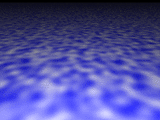 |
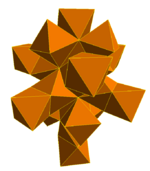 |
|
| Projections (Flattening) | ||
| Schlegel Diagram | 2D Flat View | 3D Flat View |
 |
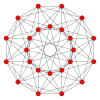 |
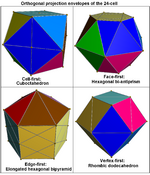 |
Orthogonal Projection
Imagine shining a light through a 3D object onto a flat wall to see its shadow. That's a projection. For 4-polytopes, we can project them onto 2D or 3D space.
- A 2D projection might look like a drawing of lines and points.
- A 3D projection can show the outer "shell" of the shape.
Perspective Projection
This is like taking a photo. A Schlegel diagram is a common way to do this. It projects the 4-polytope onto a 3D space. It shows the vertices, edges, faces, and cells as if they were inside a giant sphere.
Sectioning (Slicing)
Think about slicing an orange. Each slice shows a 2D circle. If you slice a 3D polyhedron, you get a 2D shape. If you slice a 4-polytope, you get a 3D shape! By looking at many slices in a row, you can get an idea of the whole 4D shape. Sometimes, these slices are animated to show how the shape changes over "time" (the fourth dimension).
Nets (Unfolding)
A net of a 4-polytope is like unfolding it into 3D space. Imagine unfolding a cardboard box; its faces lie flat. For a 4-polytope, its 3D "cells" would be connected by their faces and lie flat in 3D space.
Understanding 4-Polytope Types
Just like we classify animals or plants, mathematicians classify 4-polytopes based on their features.
Key Features for Classification
- Convexity: A 4-polytope is convex if it doesn't "bend in" or cross itself. If you pick any two points inside a convex 4-polytope, the line connecting them stays entirely inside. If it's not convex, it might be a star 4-polytope, which looks spiky.
- Regularity: A 4-polytope is regular if all its parts are exactly the same. This means all its cells are identical regular polyhedra (like cubes or tetrahedrons), and all its vertices look the same.
- Semi-regularity: A 4-polytope is semi-regular if all its vertices are the same, and its cells are regular polyhedra. The cells might be different types, but their faces must be the same kind of polygon.
- Uniformity: A 4-polytope is uniform if all its vertices are the same, and its cells are uniform polyhedra. The faces of a uniform 4-polytope must be regular shapes.
- Prismatic: A 4-polytope is prismatic if it's made by combining two or more simpler shapes. For example, the tesseract can be seen as a "product" of a cube and a line segment.
- Tessellations (Honeycombs): These are infinite patterns that fill up 3D space, like a honeycomb. They are like infinite 4-polytopes. The cubic honeycomb is a famous example, where cubes fill all of 3D space without gaps.
Main Categories of 4-Polytopes
Here are some of the main groups of 4-polytopes that mathematicians study:
Uniform 4-Polytopes
These are shapes where all vertices are identical.
- Convex Uniform 4-Polytopes: There are 64 of these, plus two endless families.
- The 6 regular 4-polytopes (like the tesseract) are part of this group.
- There are also prismatic types, like polyhedral hyperprisms (which include the hypercube).
- Non-convex Uniform 4-Polytopes: These are the spiky or self-intersecting ones.
- There are 10 regular star 4-polytopes. The great grand stellated 120-cell is the largest of these, with 600 vertices.
Other Convex 4-Polytopes
These include shapes like:
- Polyhedral pyramids (a 3D polyhedron extended into 4D)
- Polyhedral bipyramids
- Polyhedral prisms
Infinite 4-Polytopes (Honeycombs)
These shapes fill up space without end.
- In Euclidean 3-space: There are 28 convex uniform honeycombs. The regular cubic honeycomb is one example, where cubes perfectly fill 3D space.
- In Hyperbolic 3-space: There are 76 types of these honeycombs in a special kind of curved space.
Dual Uniform 4-Polytopes
For many uniform 4-polytopes, there's a "dual" shape. These duals have identical cells.
- There are 41 unique dual convex uniform 4-polytopes.
Abstract Regular 4-Polytopes
These are shapes that exist more in mathematical ideas than in physical space. They don't always look like "normal" shapes.
- The 11-cell
- The 57-cell
These categories cover 4-polytopes with a lot of symmetry. Many other 4-polytopes exist, but they are not studied as much because they are less "perfect."
Images for kids
-
The tesseract as a Schlegel diagram
See Also
 In Spanish: Polícoro para niños
In Spanish: Polícoro para niños
- Regular 4-polytope
- 3-sphere – This is like a sphere in 4D space. It's not a 4-polytope because it doesn't have flat "cells" as its boundaries.
- The duocylinder is another 4D shape. It's also not a 4-polytope because its boundaries are not polyhedral.


